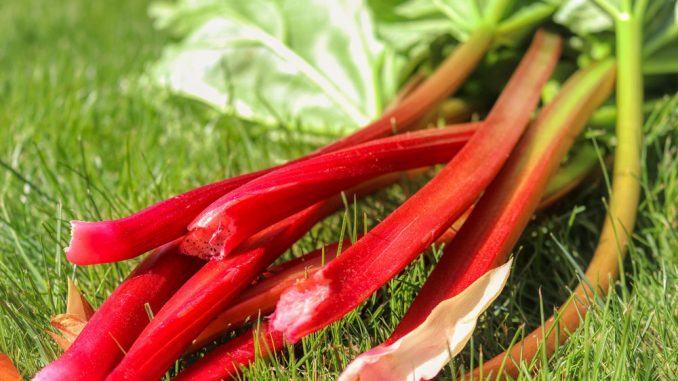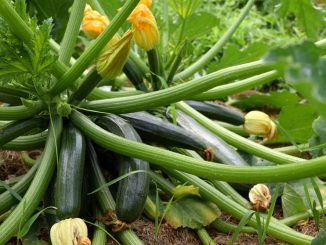
Contents
Slightly tart, but very refreshing: the stalks of rhubarb have a distinctive flavor. In May and June, you can harvest the delicious vegetable and freeze it or use it directly to make delicious desserts, jams and cakes. How good that rhubarb is a plant that is as uncomplicated as it is easy to care for, growing in any garden and even on the balcony.
Harvest & freeze rhubarb: The most important things in a nutshell
- Period: May to June 24
- Pull out rhubarb leaves with a “jerk”.
- The older the stalks, the woodier. Therefore, you should harvest the stalks while they are still young
- Important: do not harvest more than half of the leaves in total
- To freeze, clean stems, peel, cut into small pieces and place in a freezer bag
There are a number of varieties that can be divided into three groups: Green-stemmed varieties with green flesh develop into large plants with high yields. In return, they are relatively tart. Much milder are varieties with red stems and green flesh. Finally, the third group has both red stems and red flesh that is tender and low in tartness. The red-stemmed varieties are also called “raspberry” or “strawberry” rhubarb because their flavor is somewhat reminiscent of berries.
How is rhubarb harvested properly?
While the tender red-fleshed rhubarb stalks are used entirely, older green-fleshed varieties usually still need to be peeled. You’ll notice if the stalks are fibrous as soon as you cut them. You can pull off the strings with a knife. Generally, the older the stems, the woodier they are. Therefore, harvest the stems while they are still young, as soon as the leaves have unfolded. However, in order not to weaken the perennial too much, you should not harvest more than half of the leaves.
There are now also rhubarb varieties that can often be harvested from April until late October: the so-called autumn rhubarb. Strong-growing varieties such as “Livingstone” can also be harvested in the first year.
How long can you harvest rhubarb?
The harvest usually begins in May. As soon as the leaf stalks are thick enough, you can harvest the rhubarb. After June 24, rhubarb is usually not harvested. For one thing, the plants now need time to recover from the harvest, and for another, the oxalic acid content in the stems also increases. Although the concentrations are harmless to health, they are detrimental to the taste. The rest of the year, the large leaves of rhubarb decorate the garden. Further care is usually not necessary. For vigorous plants, feel free to leave one of the impressive flowers for ornamentation.
Can you freeze rhubarb?
If your harvest is so rich that you can not use all the rhubarb at once, you can easily freeze it. To do this, clean and peel the stalks as usual and cut them into small pieces. Then place them directly into a freezer bag and freeze. If you have plenty of freezer space, you can also first lay out the individual pieces in a compartment and let them freeze for about two hours before they too can move into a freezer bag. This procedure has the advantage that the individual pieces are easier to remove later. Frozen rhubarb will keep for about a year.
Growing rhubarb successfully
Rhubarb is a hardy plant that is rarely affected by pests or disease. It is best to plant it in a sunny spot. However, it can also do well in light shade, such as under a small fruit tree. It is important that it grows in loose soil where its root system can fully develop. The large leaves evaporate a lot of water, but well-rooted plants usually do not need watering. Only in dry weather in the spring should you reach for the watering can. This will benefit the quality of the stems, because in the absence of water they become woody.
Rhubarb needs sufficient nutrients for the mighty foliage it develops each year. Spread about three to five liters of mature compost around the plant at budbreak in March. Alternatively, you can fertilize with horn shavings or horn meal: Give a handful each twice in spring and work it lightly into the soil.
Harvest rhubarb: Also as a pot plant
Rhubarb can be grown very well in pots on the terrace or balcony. If you bring potted rhubarb into the greenhouse in February, it will sprout and can be harvested weeks earlier. However, this is very demanding on the plant and should therefore only be done every two years.
Rhubarb is also well suited for balconies and terraces. Especially in summer, however, it needs a lot of water because of the high evaporation through the large leaves. The potting substrate should be loamy and humus rich.
Place the pots the rest of the year half-buried in the garden, preferably slightly shaded. There they will be cared for normally. If the plants are on the balcony all year round, they should be given spacious flower pots. They thrive best in partially shady areas with a very good water supply, regular watering is mandatory so that the large leaves do not dry out. A thin layer of mulch on the pot ball lowers evaporation. Red-stemmed varieties are best for growing in pots. They do not grow as large as the green-stemmed forms.




Leave a Reply